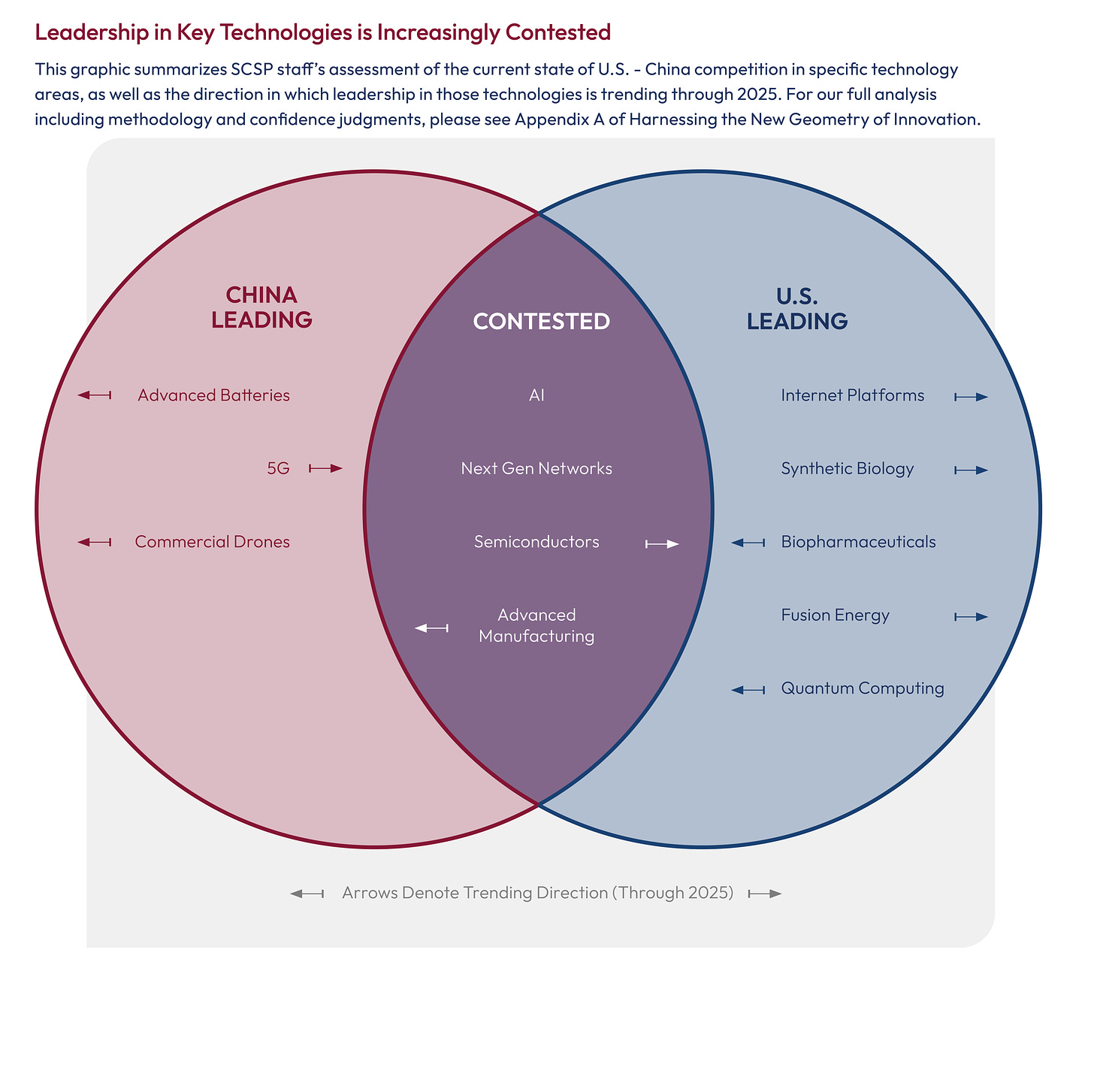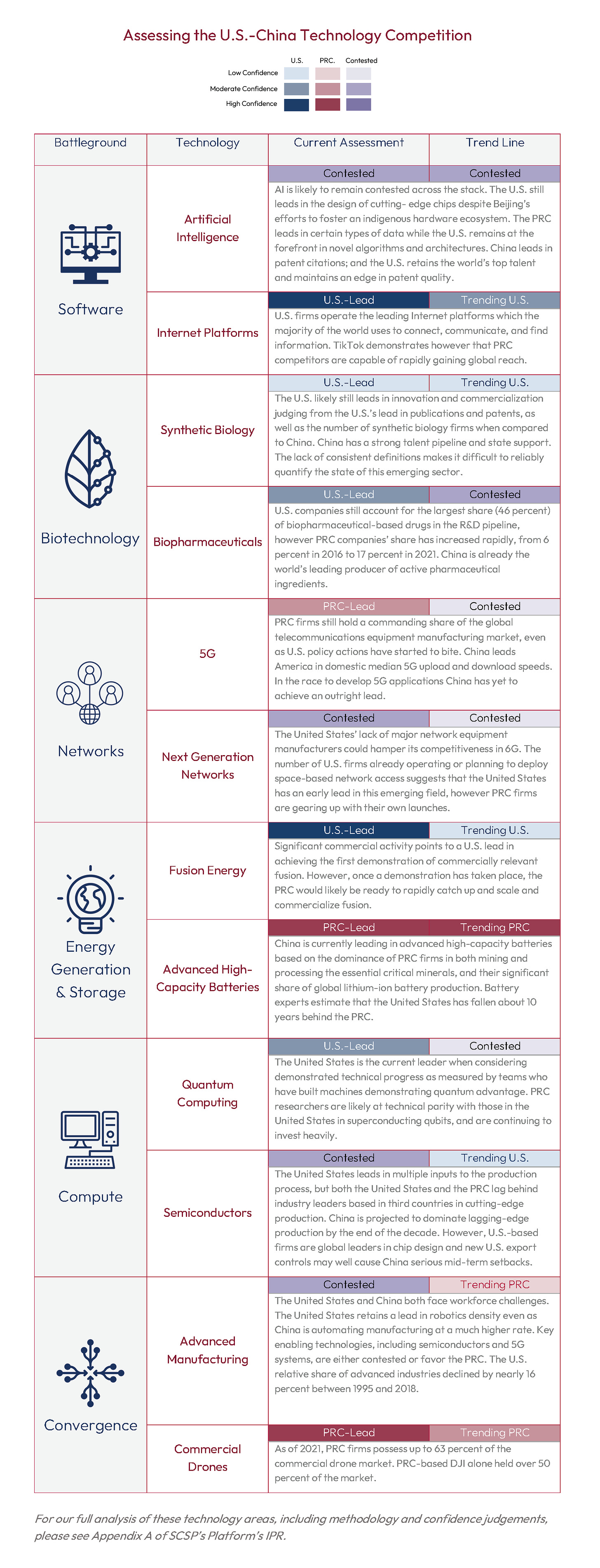|
|
A Memo for the President on U.S. Technology Competitiveness[color=var(--print_on_web_bg_color, var(--color-primary))]
[color=var(--print_on_web_bg_color, var(--color-primary))][color=var(--print_on_web_bg_color, var(--color-primary))]2-2-2
[color=var(--print_secondary, var(--print_secondary_on_web_bg_color, var(--print_secondary, var(--color-secondary))))]Nov 22
[color=var(--print_on_web_bg_color, var(--color-primary))][url=][/url]
[color=var(--print_on_web_bg_color, var(--color-primary))] Hello, I’m Ylli Bajraktari, CEO of the Special Competitive Studies Project. In this edition of 2-2-2, the Platforms panel outlines evolving technology gaps between the United States and China. Our analysis is presented in the style of a [color=var(--print_pop)]Presidential Daily Brief. This analysis is an example of the type of product that an organization dedicated to maximizing the potential of open-source information could produce.
[color=var(--print_on_web_bg_color, var(--color-primary))]
[color=var(--print_on_web_bg_color, var(--color-primary))]In this edition of 2-2-2, Senior Advisor for Platforms PJ Maykish and Platforms Panel members Abigail Kukura and Will Moreland analyze by sector the PRC challenge to U.S. Leadership in Key Technologies of Future.
SCSP Platforms Panel Releases Interim Panel Report
[color=var(--print_on_web_bg_color, var(--color-primary))]You can view the reports by clicking the links above or by visiting our [color=var(--print_pop)] website. [color=var(--print_on_web_bg_color, var(--color-primary))]Reach out to [color=var(--print_pop)] info@scsp.ai with any questions!
[color=var(--print_on_web_bg_color, var(--color-primary))]The following analysis is an attempt to emulate the style of a Presidential Daily Brief but drawn from open-source information. This type of two-sided analysis is difficult based on legal and organizational constraints. Comparing tech sectors between the United States and China is a classic example of this dilemma. Tech-specific comparisons are particularly difficult for the U.S. Government because so much of the progress takes place in the private sector far from the focus of traditional intelligence analysis. Yet that same non-government focus means there is usually vast, albeit scattered, data available ranging from academic papers to corporate reports and economic statistics. The results below are a snapshot in time as the two-largest economies in the world compete in rapidly evolving strategic technology sectors. The broader point is that to build a long-term competitive strategy, the United States needs two-sided technology analysis which begins with solving the traditional barriers to performing that comparative analysis. Our leaders need to know where we are in the competition in order to guide strategy and move resources. [color=var(--print_on_web_bg_color, var(--color-primary))] These assessments were derived using the methodology described in Appendix A of SCSP’s Platforms Panel Interim Panel Report, [color=var(--print_pop)]Harnessing the New Geometry of Innovation. For more detailed analysis of each technology see Appendix B of the same report. This analysis is also an example of the type of technoeconomic analysis that can be generated using open sources. For more information, see SCSP’s Intelligence Panel Interim Panel Report, [color=var(--print_pop)]Intelligence in An Age of Data-Driven Competition.
PRC Poses Serious Challenge to U.S. Leadership in the Key Technologies of the Future
[color=var(--print_on_web_bg_color, var(--color-primary))]The People’s Republic of China (PRC) leads in 5G, advanced batteries, and commercial drones while the United States leads in sectors like internet platforms such as social media, synthetic biology, biopharmaceuticals, quantum computing, and fusion energy. Other technologies are contested, including AI, next generation networks, semiconductors, and advanced manufacturing. In many cases, trend lines point to tenuous leads lost and the seeds of new gaps being sown. The PRC has harnessed its system to forge national technology advantages, while the United States has been caught flat-footed and forced into a reactive posture. The “gaps” that exist today demonstrate the need for a more organized U.S. approach. [color=var(--print_on_web_bg_color, var(--color-primary))]While neither an exhaustive nor comprehensive net assessment of the United States and the PRC across all technology sectors, an analysis of a subset of technologies in six core sectors serves as an early warning indicator that America’s technology leadership is not assured.
[color=var(--print_on_web_bg_color, var(--color-primary))]
[color=var(--print_on_web_bg_color, var(--color-primary))]The above board is divided, and shifting. In some technologies, the United States maintains a tenuous lead, in others the PRC appears to have surged ahead, and in others still there is a heated contest. Examining sector by sector, we find:
[color=var(--print_on_web_bg_color, var(--color-primary))]
[color=var(--print_on_web_bg_color, var(--color-primary))]In conclusion, our analysis shows how China has been able to align its innovation ecosystem with its strategic national needs and make significant in-roads towards advantages in key technology areas. The gaps illustrated above ultimately result from a contest of innovation ecosystems. They reflect the PRC’s success to date in aligning venture capital with national priorities, focusing innovation actors on closing technology gaps, designating national champions, and compelling “military-civil fusion” to incentivize, co-opt, and, if needed, compel private actors to support national objectives. For further analysis of these dynamics and recommendations for how the United States can better harness America’s strengths for this techno-economic competition, see SCSP’s Platforms IPR, [color=var(--print_pop)] Harnessing the New Geometry of Innovation.
[color=var(--print_on_web_bg_color, var(--color-primary))]SCSP’s Call for Engagement [color=var(--print_on_web_bg_color, var(--color-primary))]From May 2 to July 29, 2022, SCSP accepted submissions in the form of a short paper or video answering a [color=var(--print_pop)] Call for Engagement. [color=var(--print_on_web_bg_color, var(--color-primary))]A [color=var(--print_pop)] submission by William Healzer, Kyle Duchynski, and Jonathan Deemer, graduate students at Gordian Knot Center for National Security Innovation Stanford University was selected by the review board. Thank you to William, Kyle and Jonathan!
|
|